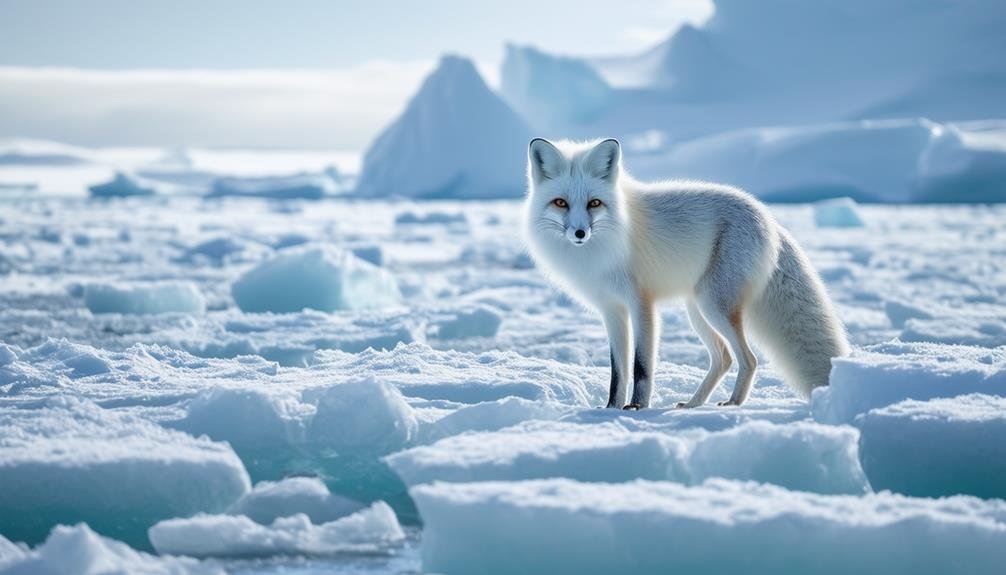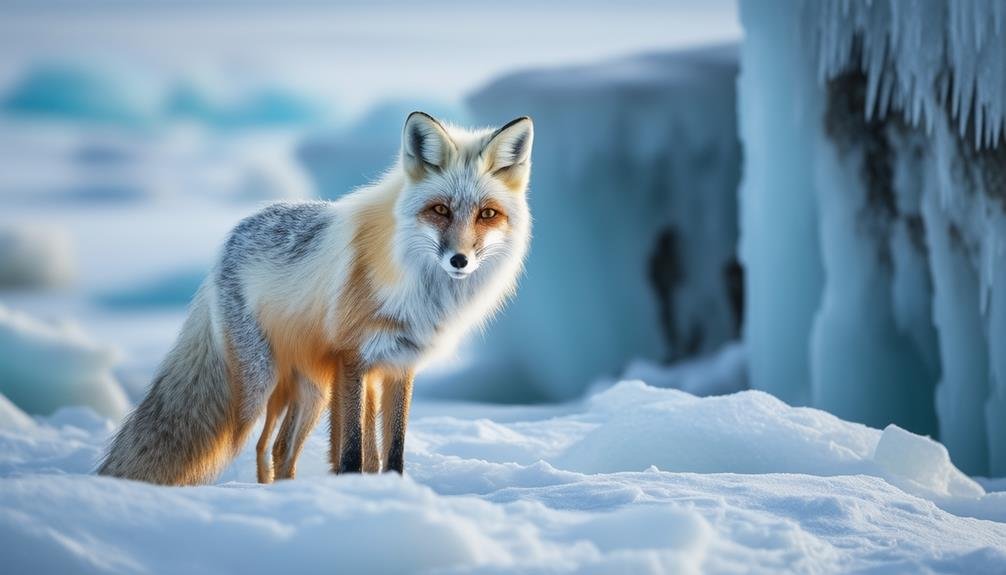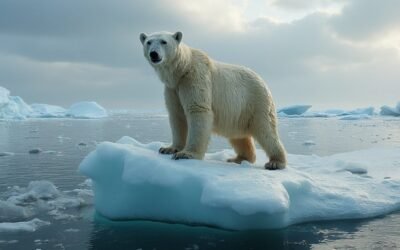Arctic foxes thrive in diverse polar habitats. Coastal Tundra offers abundant marine food sources and supports various prey, especially during migration seasons. Alpine Tundra provides extreme conditions, rocky dens, and small mammal prey, crucial for survival. Sea Ice acts as a hunting platform, safe breeding ground, and essential migration route, though it faces climate change threats. Boreal Forest Edge blends forest cover with open tundra, offering protection and diverse prey. Finally, Arctic Islands provide isolation, minimal predator competition, and plenty of prey and shelter. Understanding these habitats reveals more about the resiliency and adaptability of Arctic foxes.
Main Points
- Coastal tundra offers marine food sources and diverse prey, crucial during migration seasons.
- Alpine tundra provides camouflage and insulation, with rocky outcrops for dens and small mammals to hunt.
- Sea ice serves as a hunting platform, breeding ground, and migration route, though threatened by climate change.
- Boreal forest edge combines forest cover with open tundra, providing abundant prey and protective denning sites.
- Arctic islands offer minimal competition, a variety of prey, and abundant denning sites for isolated survival.
Coastal Tundra
The coastal tundra provides an important habitat for Arctic foxes, offering access to a diverse array of marine and terrestrial food sources. These regions are particularly advantageous due to the proximity to open water, which guarantees a steady supply of marine food sources such as fish, seals, and seabirds. This availability of varied prey options is vital for the Arctic fox's survival, especially during the harsh winter months when terrestrial food becomes scarce.
In addition to these marine food sources, the coastal tundra ecosystem supports an abundance of marine invertebrates and waterfowl, further broadening the prey options for Arctic foxes. The combination of land and sea in these habitats creates a rich and varied ecosystem, providing the necessary sustenance for Arctic foxes throughout the year.
Moreover, coastal tundra areas are essential during migration seasons, offering both food and shelter along the foxes' journey. The intricate web of interactions within the coastal tundra ecosystem underscores its significance for the Arctic fox population. By supporting a diverse range of prey, from seals to marine invertebrates, these habitats play an important role in the survival and well-being of Arctic foxes.
Alpine Tundra
Beyond the coastal tundra, Arctic foxes also inhabit the high-altitude alpine tundra, where they endure extreme conditions and restricted resources. This environment is characterized by cold temperatures, strong winds, and substantial snow cover. Despite these harsh conditions, Arctic foxes are well-adapted to thrive in this habitat. Their white winter coat provides essential camouflage and insulation, allowing them to blend into the snowy landscape.
Arctic fox dens are typically located in rocky outcrops, offering protection from predators and the elements. These denning sites are strategically chosen for their proximity to food sources. The alpine tundra's open spaces facilitate hunting for small mammals such as voles and lemmings, which are vital to their diet. Fluctuating lemming populations can significantly impact the availability of food, prompting Arctic foxes to migrate in search of more abundant resources.
In addition to small mammals, Arctic foxes also prey on birds and insects, adapting their diet to the limited food sources available in this environment. Snow dens, built into the drifts, provide necessary shelter and warmth during the coldest months. Overall, the alpine tundra's unique conditions create a challenging but suitable habitat for Arctic foxes.
Sea Ice

How do Arctic foxes navigate and thrive within the dynamic and precarious environment of sea ice? Sea ice plays a pivotal role in the survival of Arctic foxes, providing a unique and essential habitat. This frozen expanse is not just a hunting ground but a lifeline for these resilient creatures.
Arctic foxes exploit sea ice as a platform for hunting, accessing vital marine food sources such as seals and seabirds. The ice allows them to travel vast distances, essential for finding food and evading predators. It also serves as a stable environment where they can build dens, offering protection and a secure breeding ground. Additionally, sea ice forms critical migration routes that connect various habitats, facilitating movement and genetic exchange among populations.
However, the stability of this habitat is under threat due to climate change, which has a profound impact on populations by altering the availability and accessibility of sea ice.
- Hunting Platform: Sea ice provides a stable platform for hunting marine food sources.
- Migration Routes: Essential for seasonal movements and genetic diversity.
- Breeding Grounds: Safe environment for raising young.
- Predator Protection: Natural barrier against terrestrial predators.
Understanding the intricate relationship between Arctic foxes and sea ice highlights the importance of preserving this fragile habitat.
Boreal Forest Edge
Nestled at the edge of boreal forests, Arctic foxes find a habitat that seamlessly blends forest cover with open tundra, offering a diverse range of resources essential for their survival. This unique pivotal zone is abundant with small mammals, birds, and insects, providing a reliable food source for these resilient animals. The boreal forest edge not only supplies ample resources but also offers vital shelter from harsh weather conditions and predators.
Arctic foxes benefit from the protective cover of the forest, which allows them to establish dens where they can raise their young safely. These dens are often strategically located to maximize access to both the forest and the tundra, enabling the foxes to exploit various food sources and adapt to changing environmental conditions.
The edge of boreal forests is a dynamic environment where Arctic foxes can thrive, thanks to the combination of resources and shelter it provides. The ability to adapt to these diverse conditions is pivotal for their survival, as it allows them to navigate the challenges posed by fluctuating climates and varying prey availability. Overall, the boreal forest edge stands out as an ideal habitat for Arctic foxes to flourish in the wild.
How Do the Arctic Fox’s Behaviors Adapt to Its Habitat in the Wild?
The Arctic fox lives in extreme cold and has developed survival tactics suited to its environment. Among the best behaviors of arctic foxes are their ability to dig dens for warmth and camouflage in the snow to avoid predators. Their seasonal coat changes also provide additional protection and blending capabilities.
Arctic Islands

While the edge of boreal forests offers a blend of resources and shelter, Arctic islands provide an equally advantageous but distinct habitat for Arctic foxes, owing to their remote and isolated environment. These islands create an environment where the foxes can thrive with minimal competition from larger predators, facilitated by their unique ecological conditions.
The remote and isolated Arctic islands offer a variety of prey species, including seabirds, marine invertebrates, and small mammals, ensuring a consistent food supply for Arctic foxes. The harsh environment of these islands plays a pivotal role in minimizing competition, allowing Arctic foxes to occupy a niche where their specialized adaptations, such as their thick fur and keen hunting skills, are highly beneficial for survival in extreme cold conditions.
Additionally, Arctic islands provide abundant denning sites and shelter, which are essential for the safety and upbringing of their young. The foxes utilize these denning sites to protect their offspring from the elements and potential threats.
Conclusion
The diverse habitats of coastal tundra, alpine tundra, sea ice, boreal forest edge, and arctic islands collectively provide the key environments required for the survival and adaptation of arctic foxes. Each habitat offers unique resources and conditions that support the species' dietary, reproductive, and shelter needs. Understanding these habitats is vital for conservation efforts, ensuring that arctic fox populations remain resilient against the challenges posed by climate change and human activities.


